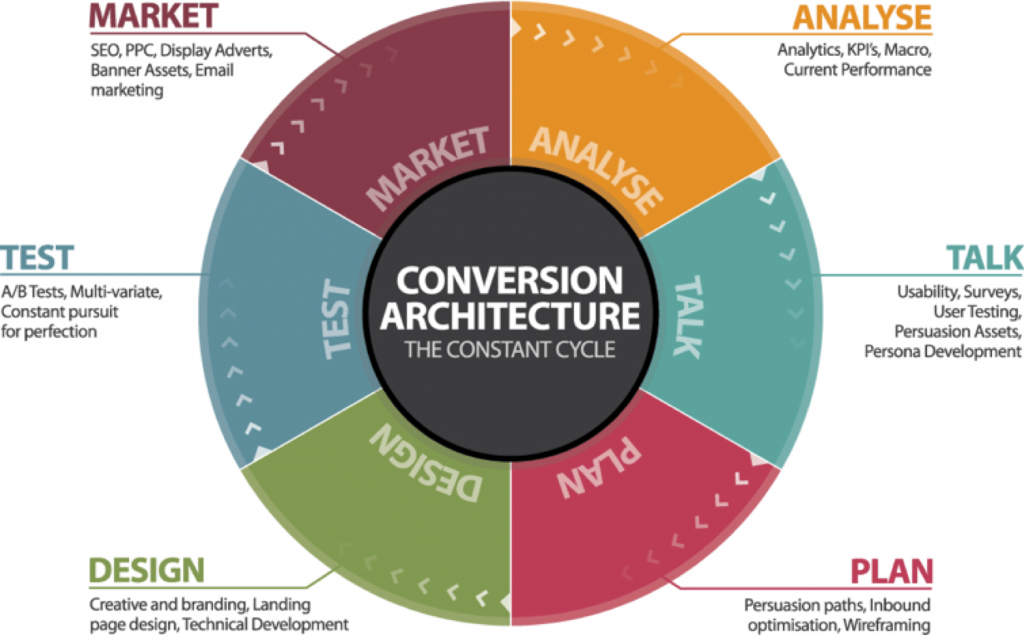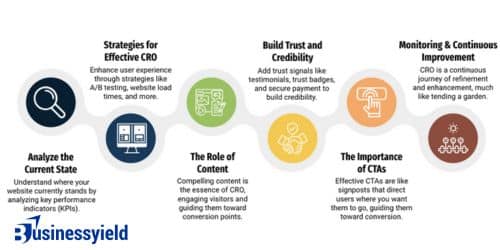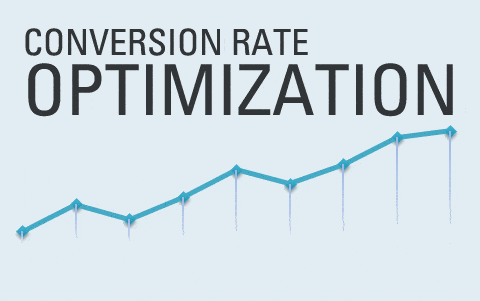Conversion rate optimization (CRO) converts website visits into customers or leads.
Instead of wasting valuable time and money acquiring new visitors, increasing your conversion rate will generate more value from your existing customers.
This guide will break down CRO in simple terms, show you how to calculate your conversion rate and get you started with some fundamental conversion optimization tasks.
What is Conversion Rate Optimization?
Conversion rate optimization (CRO) is the systematic process of improving the number of website visitors who complete a desired action, such as filling out a form or becoming clients. The CRO process entails studying how users navigate your site, what actions they take, and what is preventing them from achieving your objectives.
What is a Conversion Rate?
A conversion rate is the percentage of visitors who do the requested action, such as filling out a web form, signing up for a service, or purchasing a product.
A good conversion rate indicates that your website is well-designed, formatted correctly, and appealing to your intended audience. A low conversion rate could be due to many issues, including website performance or design.
Slow load times, a faulty form, or a copy that does not communicate the value of the offer are all common causes of a low conversion rate.
Key Takeaway
- Conversion Rate Optimization (CRO) is a systematic process aimed at increasing the percentage of website visitors who complete a desired action, such as making a purchase or filling out a form.
- A good conversion rate is indicative of a website’s effective design and appeal to its target audience, with factors like industry, niche, and traffic channels influencing what constitutes a “good” rate.
- Implementing A/B testing, optimizing for mobile users, and enhancing user experience are key strategies for improving website performance and increasing conversion rates.
- CRO not only lowers the cost per acquisition but also provides a deeper understanding of customer behavior, offering a competitive edge and potentially increasing sales and revenue.
- Advanced CRO strategies include leveraging AI for predictive analytics and personalization, optimizing for voice search, and ensuring privacy-first optimization amidst tighter data collection restrictions.
What is a Good Conversion Rate?
Industry, niche, goals, traffic channel, and audience demographics are just a few of the factors that determine a “good” conversion rate.
As of 2023, the average conversion rate for e-commerce sites is 2.86%, showcasing a slight increase from the previous year, emphasizing the growing efficiency of CRO strategies. (Source: Optimizely/Statista)
If your conversion rate is lower than you’d like—whether it’s below average in your industry, lower than your best competitors, or simply underperforming against your own objectives—it’s time to optimize.
Conversions can occur throughout your website, including your homepage, pricing page, blog, landing pages, and more. To increase the likelihood of turning website visitors into paying clients, improve each place.
Research indicates that websites utilizing advanced CRO tools and techniques can see an improvement in conversion rates of up to 30%. (Source: CRO Platform Report 2023)
Before we look at the benefits of CRO, let’s go over how to calculate your website’s conversion rate.
That way, you’ll have a better idea of how much time and money to invest in a CRO plan.

How Do You Calculate a Conversion Rate?
To determine and compute your conversion rate, divide the number of conversions by the total number of visitors and multiply by 100.
Conversion rate = (conversions/visitors) x 100.
Keep track of any modifications you make to your site and regularly measure your conversion rate to see if they enhance conversions.
Benefits of Conversion Rate Optimization
Website conversion rate optimization improves everything from marketing expenditures to sales processes.
Let’s look at these advantages in more detail:
- Lower cost per acquisition (CPA): CRO can reduce your overall CPA because you will not have to invest in as many channels (particularly paid ads) and methods to generate conversions.
- Greater understanding of customers: CRO entails detailed research that will help you better understand your audience and what pushes them to behave.
- Improved competitive advantage: CRO allows your site’s pages to generate more results than your competitors’ non-optimized material.
- Increased sales and revenue: CRO encourages more people to convert, which can help produce more sales and increase your revenue.
- Lower effort activity: CRO uses current content to convert more users, so you don’t have to start from zero.

Effective Conversion Rate Optimization Strategies
You can use these eight strategies to improve your website’s performance and increase conversions:
- Optimize the user experience.
- Optimize your messaging.
- Create buyer personas to better understand your customers.
- Optimize with hard data.
- Set SMART goals for CRO.
- Test your CRO strategies.
- Conduct competitive research.
- Conduct user research.
#1. Optimize the user experience.
According to AWS research, 88% of online consumers claimed they would not return to a website if they had a negative user experience, hence, UX optimization is critical for CRO.
To improve UX, consider employing the following tactics:
- Optimize the layout of your web pages such that the most captivating and intriguing material is visible in key sections.
- Be aware of user device preferences for visits and conversions, and tailor the page experience to mobile and desktop devices as appropriate.
- Add a site search and consider employing live chat. Use pop-ups sparingly.
- Add more (or better) social evidence, such as customer reviews and user-generated material, to boost your legitimacy and consumer trust.
- Improve the usability of online forms and CTAs.
- Ensure that all web forms are straightforward, clear, and easy to fill out.
- To increase conversion rates, personalize your CTAs.
- Make sure the CTAs are easy to understand.
- PageSpeed Insights and Pingdom are useful tools for testing your site’s speed and troubleshooting common issues.
- Make it simple for clients to make purchases from your e-commerce pages. Make sure they don’t have to log in to start shopping. Instead, use optional login and sign-up fields to allow “guest purchases”.
- Make sure to send follow-up emails to clients who have abandoned carts.
- Provide incentives, like free shipping for a limited time.
#2. Optimize your messaging.
The first step in optimizing your messaging is to analyze your buyer personas (as shown below). Make sure you know and comprehend your client’s needs, wants, and objectives.
You may then optimize your messaging for your ideal clients using the following tactics:
- Optimize your website’s landing pages. Make sure your landing pages are consistent with your messaging and the material or ad that directed them there.
- Use and optimize lead magnets. These are free materials that you distribute in return for user data, such as email addresses, (while adhering to data privacy guidelines). Different lead magnets should correspond to specific stages of the buyer’s journey. Customers at the awareness stage, for example, are typically given access to checklists and online quizzes. Case studies and vouchers are more useful to clients during the conversion and retention stages.
- Optimize your content, title tags, and meta descriptions to match top-performing keywords. Ensure that your term is utilized multiple times throughout your article, but avoid keyword stuffing.
- Target high-intent users and learn what works for them. These users are on the verge of making a conversion and are extremely valuable. You may target high-intent consumers by including high-intent keywords in your landing pages and creating content that explicitly addresses customer pain points.
#3. Create buyer personas to better understand your customers
To improve your consumers’ experiences on your website and encourage them to convert, you must first understand who they are, what inspires them, and what they want your product to do. You can create buyer personas to help you discover and apply this knowledge to your content, site layout, and CTAs.
A buyer persona describes your ideal consumer. To create a buyer persona:
- Read the customer reviews.
- Ask customers questions through polls or surveys.
- Analyze your customer data.
- Engage consumers and prospects in conversations.
#4. Optimize with hard data
Optimize your website using high-quality data, not feelings, emotions, or instincts. You may use an analytics tool like Google Analytics to get hard data on your bounce rate, exit pages, cost per conversion, and other crucial metrics, and then take specific actions to improve these areas.
- Bounce rate. A high bounce rate is generally defined as anything greater than 56%. If your bounce rate falls into this category, take action immediately. Concentrate on your primary pages and strive to improve their content.
- Pages that lead to an exit. Use an analytics tool to discover your exit pages, then investigate why users are leaving your site from those pages and address the issues. You can accomplish this by reviewing and enhancing the content on your departure pages to make it more relevant to visitors.
- Cost per conversion. If you’ve enabled conversion tracking in your analytics program, you may determine how much each conversion on your website costs. This indicator can help you determine whether your marketing budget is cost-effective.
#5. Set SMART goals for CRO
To boost CRO performance, always develop SMART goals (specific, measurable, achievable, relevant, and time-bound).
For example:
Do not mention, “My goal is to increase conversions.”
Put it this way: “My goal is to increase conversions by 10% in the next 3 months by implementing a targeted email campaign.”
#6. Test your CRO strategies
To test your CRO strategy, you can employ A/B or multivariate testing. For optimum results, combine both test types.
An A/B test is also called a split test. It enables you to directly compare items on two web pages. This test is especially good for assessing headlines, calls to action, pictures, and content.
A multivariate test examines several variants of several items on a webpage. The purpose of this test is to see which combination of variations works the best.
Keep in mind that CRO testing, like everything else in digital marketing, is a continuous process. It’s an iterative process that takes time to show a rate of results.
You can use a range of tools to help you carry out your tests. Here are three common tools for testing updates to your website:
- Google Optimize
- VWO Testing
- Instapage
Read Also: The Role of Web Design in the Success of Modern Businesses
Below are some best practices for CRO testing:
- Conduct an A/B test: To test your modifications, perform an A/B or split test. This allows us to see how changing one variable affects the test results. For example, does changing the CTA button from blue to green result in more conversions?
- Save time by using Tampermonkey: This free browser extension allows you to execute user scripts on websites, which are little computer programs that change the appearance of a page and add or remove functionality and content.
- Maintain query parameters: When visitors visit your website, the parameters in their URLs contain essential information, such as where they came from. When running tests and experiments, attempt to keep your query parameters.
- Test across numerous devices, operating systems, and browsers. Make sure they operate properly on each one.
- Ensure statistical significance: When a result is significant, you can be convinced that it is genuine and not the result of chance with your sample. Make certain that your sample size is sufficient to give a relevant result.
#7. Conduct competitive research
Assess your competition on a regular basis to see what strategies are working for them. Your goal is not to replicate their high-performing ideas and techniques but to draw inspiration from them and incorporate new elements into your own actions.
To evaluate your competitors, you can conduct three sorts of audits:
- Content audit: A content audit reveals what type of content your competitors are sharing with their consumers. You can then compare their content strategy with your own.
- SEO audit: An SEO audit involves looking at the keywords your competitors are utilizing and evaluating their overall SEO strategy. You can run an SEO audit using a variety of tools, including Ubersuggest.
- Social Media Audit: To do a social media audit of your competitors, just follow them on social media and keep track of the posts, content, and social activities that seem to perform well and resonate with their audiences.
#8. Conduct user research
Your goal with this form of research is to learn exactly how visitors engage with your website. You’d also like to know how they got to your website. Furthermore, it is critical to determine whether they experience any obstacles when using your website, particularly those that impede them from converting, and, conversely, which portions of their visit go easily.
During user research, you will also analyze:
- There are technical issues with your website, such as faulty links.
- Poor navigation is one example of user interface (UI) difficulties that have an impact on the user experience.
- How consumers view your website overall
- Best tools for user research in CRO
You can use various tools for user research, such as:
SEO tools, such as Screaming Frog, can help you evaluate technical issues with your website.
Analytics technologies, such as Google Analytics, determine what visitors do on your website.
Heat-mapping and mouse-tracking technologies, such as Hotjar, can help you visualize how users interact with your website and track mouse movements and clicks.
Form-tracking software, such as Zuko, can identify patterns of behavior in your web forms.
Best practices in user research for CRO
Here are some best practices when conducting user research:
- Avoid rabbit holes: Be clear about the scope of your study, and ensure that it is properly planned and organized.
- Look for overlap between sources: Examine the overlaps between the various data sources critically.
- Analyze your competitors’ approach: Determine which components of their websites are effective.
- Document your findings: This allows you to identify important insights when you need them, answer particular queries, monitor developing patterns, and analyze past data.
After you’ve done your user research, you can use the information you’ve gathered to identify and objectively prioritize CRO testing opportunities. The optimizations you prioritize should be aligned with your business goals and have the most impact on your business.
When considering CRO adjustments, you can think large and be ambitious, but you must keep the essentials in mind. Remember that well-designed web pages, engaging content, and straightforward navigation earn clients’ trust and should always be your top objectives.
The CRO checklist below can help you enhance your conversion rate optimization strategy.
How Can I Enhance My Conversion Rate?
To improve your website conversion rate, use CRO tools to analyze web pages that are underperforming in relation to your conversion goals, and determine what is preventing visitors from taking a desired action, such as clicking a CTA button, joining an email list, or adding something to their shopping cart.
Once you’ve discovered any roadblocks your website visitors are encountering, you can make better-educated decisions about what adjustments should be evaluated on your pages (using A/B testing or multivariate testing) to boost conversion rates.
Note: You should also examine your highest-converting pages to determine what works—what compels buyers to progress through the conversion funnel on those sites?
- Implementing A/B Testing:
- Use tools like Optimizely or Google Optimize to set up A/B tests.
- Start with high-traffic pages for immediate insights.
- Test one variable at a time to understand its impact.
- Optimizing for Mobile:
- Ensure your website is fully responsive.
- Use Google’s Mobile-Friendly Test tool to identify areas for improvement.
- Simplify forms and streamline navigation for mobile users.
- Enhancing User Experience:
- Utilize heat mapping tools like Hotjar to understand how users interact with your site.
- Simplify the navigation and reduce page load times using PageSpeed Insights for recommendations.
- Incorporate live chat or chatbots to address user queries in real-time.
What Tools Can Help You Analyze Conversion Rate Optimization?
To study conversion optimization, employ quantitative and qualitative CRO tools, such as Google Analytics and Hotjar, to assess your conversion rate optimization initiatives.
During your analysis, take note of these three elements to optimize efficiently:
- The factors that attract users to your website
- Barriers that could prevent or force them to leave
- Hooks that convince them to convert
Conversion Rate Optimization Tools to Help You Implement Your Strategy
Here are a few of the greatest tools to help you carry out the conversion rate optimization procedure and measure your results:
#1. SplitSignal
SplitSignal is an A/B testing tool that allows you to quickly create a hypothesis, pick variants, and execute your test.
This tool may be installed in a matter of minutes using a snippet of JavaScript, without requiring assistance from a developer.
You can also test titles, headings, element positioning, and more.
#2. Landing Page Builder
Landing Page Builder is a solution that allows you to create and launch landing pages at scale using a simple drag-and-drop editor. Allows you to perform A/B testing to boost conversions.
Because there are over 400 templates, the tool makes it quick and simple to create a landing page. To address almost every use case.
You can also develop Smart Sections—custom elements that can be reused across all of your landing pages without having to start from scratch.
#3. Plerdy
Plerdy is a suite of CRO tools centered on user experience and SEO. Additionally, it integrates with Semrush.
The Website Heatmap Tool displays the most frequently clicked items on your sites, allowing you to see what entices customers the most.
Funnel Analysis allows you to learn how your website visitors react at each stage of the funnel. So you can identify areas for improvement.
#4. Hotjar
Hotjar is a tool that provides website heatmaps and behavior analytics services to help you better understand how your audience interacts with your website.
Its heatmaps collect both click information and activities such as hesitations. And can determine where the problems are on pages that aren’t converting.
#5. Optimizely
Optimizely is a platform that provides tools for conducting experiments such as A/B and multivariate tests to determine what works. Make modifications to boost conversion rates.
It’s versatile and simple to use. In addition, the reporting feature provides detailed information about user interactions. So you may choose which version is the winner.
#6. HelloBar
HelloBar is a pop-up builder that makes it easy to add forms to your website.
These pop-ups come in a variety of formats, but they can all be used to convert website visitors into leads and consumers.
The application also allows for A/B testing, custom reporting, and analytics.
Advance Optimization Techniques and Future Trends:
- Personalization and Predictive Analytics: “Leveraging AI for predictive analytics allows for unprecedented personalization at scale,” says Alexa Rutherford, CRO Specialist at OptimizeWay. Integrating these technologies into user experiences without compromising privacy will be critical for the future of CRO.
- Immersive Technologies: “The use of VR and AR to create immersive shopping experiences is a game changer, particularly for fashion and home decor online retailers, significantly improving the online shopping experience and conversion rates,” says Jordan Lee, Director of User Experience at ConversionGenius.
- Voice Search Optimization: “Optimizing for voice search through smart devices is becoming crucial. Understanding conversational queries, intent, and context is key,” highlights Ethan Morales, CRO Consultant and Speaker.
- Privacy-First Optimization: “With tighter restrictions on data collection, the focus is shifting towards privacy-first optimization. Emphasizing user experience and leveraging first-party data will become more important,” argues Isabella Gomez, Founder of CROFirst Agency.
Common Pitfalls To Avoid In CRO
- Overreliance on Quantitative Data: “A major pitfall is focusing too much on quantitative data and neglecting qualitative insights. Understanding both is crucial for effective optimization strategies,” suggests Mia Singh, Head of Digital Marketing at GrowthHacks, Inc.
- Set It and Forget It Mentality: “CRO isn’t a one-time effort. Continuous testing and adaptation to evolving market trends and consumer behaviors are essential for maintaining relevance,” says Connor Davidson, Analytics Lead at NextGenCRO.
- Ethical Data Use: “As we leverage big data and machine learning for hyper-personalization, ensuring ethical data use and user trust is critical,” warns Derek Li, Data Scientist at DataDrivenDecisions.
Conclusion
Every website visit holds potential.
Effective CRO techniques may translate that promise into practical advantages.
Of course, using the correct strategy and tools makes things easier.
If you’re ready to get started with CRO, start with the basics, such as knowing your audience.
- CRO MARKETING: Detailed Guide To The Marketing Strategy
- HOW TO INCREASE TRAFFIC OF A WEBSITE: A Comprehensive Guide
- DIGITAL MARKETING: Definition, Types, and, Strategies
- LEAD CONVERSION: Examples and Rates






